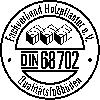The undersurface must be ready for laying in accordance with DIN 18367 “Woodblock work” No. 2.1.2. Bonded screed (“Screed mortar”) CT - C 35 F 5 to DIN/EN 13813 – January 2004 – and/or concrete B 25 to DIN 1045 must be used. (C 35 = Compressive strength to Table 2 DIN/EN 13813 = 35 N/mm² - F 5 = Bending strength to Table 3 DIN/EN 13813 = 5 N/mm²). (See also the new edition of DIN 18560 “Screeds in construction work” (2004/4))
If rising damp must be anticipated, special sealing procedures must be applied in order to prevent the woodblock absorbing moisture. If noise and heat insulation measures are necessary, a suitable floating screed must be installed. Floating screeds or screeds on a separating layer must be applied at a thickness in accordance with the traffic load envisaged by the planner. Minimum thickness 50 mm. If the envisaged surface load requires higher values, these must be agreed separately. An essential requirement for the suitability of the undersurface for woodblock is its correct composition, production and installation. The constituents must not become separated. It must be completely sealed and capable of supporting the load, and carefully treated.
The surface of the concrete or screed must be rubbed down to accept the woodblock, but not completely smoothed. It must not release sand or dust. In the case of all cement-bonded undersurfaces (CT), subsequent treatment is essential in accordance with the “Guideline on after- treatment of concrete”, e.g. by the laying of film sheets or similar (e.g. straw mats) (do not use sprays).
Note
The envisaged after-treatment is also intended
to ensure that the surface remains
sufficiently firm, and that no gaps occur
during the usual grid-gap testing. (Surface
adhesion strength = at least 1.5 N/mm²)
(Class B 1.5 Table 11 DIN/EN 13813). Surface
fillings should be avoided wherever
possible. The levelness tolerances must
at least comply with the value specified in
line 3 of Table 3 of DIN 18202.
If calcium sulphate-bonded screeds (CA)
are used, the strength class AE 30 with
corresponding surface strength and loadbearing
capacity is required.
Undersurfaces of poured asphalt (AS)
have only limited suitability for woodblock
flooring due to their hard plastic property
and restricted point-load capacity.
Undersurfaces of chipboard on wooden
constructions must be dimensioned in
order to be adequately stable, and must
be back-ventilated. The contractor must be notified of the
laying of woodblock as the upper covering
in the work specification.
Sub Floor Moisture
Rising damp from the undersurface can cause serious damage to woodblock floorings laid over such surfaces. Undersurfaces in contact with the ground must always be provided with a barrier layer against rising damp. Reference is drawn in this respect to DIN 18195 (Sealing of construction works). Insulating layers under floating screeds must also be covered by suitable material. Screeds on separate layers must also be provided with adequate sealing against rising damp from the concrete floor. Bonded screeds must be protected at the surface by suitable material (e.g. an epoxy resin coating) against damp from the undersurface. The concrete base in contact with the ground must also be sealed on the underside to the ground by means of a damp course.
Construction works intermediate ceilings also require adequate sealing against rising damp. In addition to the residual damp in fresh concrete ceilings persisting the years, unfavourable circumstances also create the risk of vapour diffusion from the rooms below. Amongst other things, a vapour barrier in the form of PE films 0.2 m/m in two layers has proven to be an effective solution. All sealing measures are the responsibility of the client or construction planner. These do not fall under the testing obligation of the contractor.
Basically there exists no freedom of judgement on the part of the planner. It is therefore recommended, in the interests of all involved, to minimise the risk of damage, by specifying and installing an adequately diffusion-proof vapour barrier (corresponding to at least one 0.5 mm thick PVC sheet) under every floating screed.


